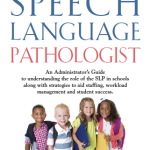Numbers vs. Need

Kudos to anyone who has a working schedule in place. Now the question is can your schedule be implemented with quality and consistency. Talking with colleagues in several states, I noted for some, caseload management is a huge issue. Almost all full time therapists have big numbers. Many report 60 to 90 students on a caseload. Some of these therapists have speech language assistants and some don’t. A good assistant can be somewhat helpful but the ultimate responsibility for the student’s programming falls on the therapists shoulders.
Over the years I’ve been lucky to work on occasion with principals, team leaders and even special education directors who for the most part were aware of caseload numbers and sometimes understood need differences. I’ve learned over the years to advocate for myself in terms of the time needed to adequately service my caseload. Sometimes the administration listened and sometimes there was no money to listen.
When assessing the needs of any special needs caseload wether it be the special education teachers caseload, the speech therapists caseload, the school psychologist caseload, the team facilitator’s caseload and even classroom placement, the students needs not just the number of students needs to be looked at. As speech therapists, we know that 60 students with developmental articulation needs is a lot easier to manage than 60 language learning disabled kids. Our caseloads are never that straight forward either. Within a group of 60 students, a typical speech language pathologist will service a variety of disabilities ranging from simple articulation errors, to language learning disabled, to low cognitive, to specific disabilities such as Aspergers and autism, to physical disabilities effecting communication and everything in between.
If a therapist has 60 students on a caseload they might miss 60-180 hours of therapy just attending annual meetings. Thats 10-20 days of therapy and at least 6 meetings a month. We can write IEP’s that involve articulation and development language delay in our sleep but children who have more complex needs, their IEP’s require more time and thought. At least a fourth if not more of the students on the caseload will require a 3 year re-evaluation. Comprehensive speech and language evaluations take anywhere from 6-12 hours to complete dependent on the students needs and if you include write up time. That’s another 90 hours or 15 days of therapy. it is almost impossible to build in time for meetings and testing when caseload numbers are big. My point is the larger the caseload numbers the more therapy will be cancelled due to other tasks because most of those tasks have to meet mandated deadlines. If the student is a more involved student all those housekeeping tasks take more time too.
Administrators, please look at caseload need when determining how many therapists you need to service your school or district. Ask your therapists what their caseload needs are not just how many students they have. Look at the schedule and see if it is even physically possible to schedule students and allow for adequate meeting and paperwork time. If a school schedule does not accommodate special education students and their needs it is your responsibility to initiate change. Speech therapists often need more paperwork time because almost every student we see has unique and significant needs. Canceling therapy is unacceptable as a solution.
Parents, at your team meeting, ask outright how many students there are on the therapists caseload. Parents don’t hesitate to question class size and caseload size is no different. If you don’t like hearing that the therapist has to service over 60 students in a week. question them as to how the therapist will manage to give your child what they need.
Therapists, advocate for yourself and speak up. If your caseload so challenging, numbers are too high and need is too great, that the children are not getting what they need and you have to cancel therapy on a regular basis, your caseload is too difficult to manage. You are not a failure if you have impossible parameters to work with. Make a list of the issues and present it to your principal, special education director and team facilitator. If you don’t educate them on caseload needs they will never understand. Even if it doesn’t help your immediate situation it may change they way they look at things in the future. Point out that an assistant is not always the answer since you have to supervise them and most are not qualified to work with more involved students.
Not all caseloads are created equal. Therapists and teachers know this. Caseload management is an issue that is talked about a lot among therapists and teachers. We know the problems but nothing will be done about it until we are able to educate our administrators on need vs. numbers.








Thank you for writing about this. Caseload size is a topic of concern for me, despite residing in a state with an abundance of SLPs. I find that students are frequently over identified as possessing speech-language disorders and consequently drive numbers up.